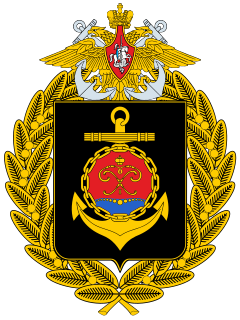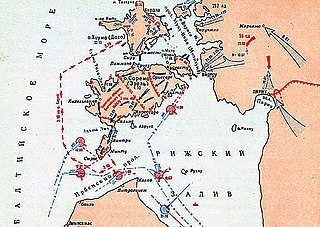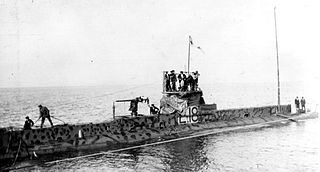Related Research Articles

The Continuation War, also known as Second Soviet-Finnish war, was a conflict fought by Finland and Nazi Germany, against the Soviet Union (USSR) from 1941 to 1944, as a part of World War II. In Soviet historiography, the war was called the Finnish Front of the Great Patriotic War. Germany regarded its operations in the region as part of its overall war efforts on the Eastern Front and provided Finland with critical material support and military assistance, including economic aid.

The Finnish Navy is one of the branches of the Finnish Defence Forces. The navy employs 2,300 people and about 4,300 conscripts are trained each year. Finnish Navy vessels are given the ship prefix "FNS", short for "Finnish Navy ship", but this is not used in Finnish language contexts. The Finnish Navy also includes coastal forces and coastal artillery.

Ilmarinen was a Finnish Navy Panssarilaiva. The unit was constructed at the Crichton-Vulcan shipyard in Turku, Finland, and named after the mythological hero Ilmarinen from the Finnish national epic, the Kalevala. Ilmarinen was the flagship of the Navy from 1 May 1933 until her sinking on 13 September 1941.

The White Sea–Baltic Canal, often abbreviated to White Sea Canal is a ship canal in Russia opened on Wednesday 2 August 1933. It connects the White Sea, in the Arctic Ocean, with Lake Onega, which is further connected to the Baltic Sea. Until 1961, its original name was the Stalin White Sea–Baltic Canal.

Kronstadt, also spelled Kronshtadt, Cronstadt or Kronštádt is a Russian port city in Kronshtadtsky District of the federal city of Saint Petersburg, located on Kotlin Island, 30 kilometres (19 mi) west of Saint Petersburg, near the head of the Gulf of Finland. It is linked to the former Russian capital by a combination levee-causeway-seagate, the St Petersburg Dam, part of the city's flood defences, which also acts as road access to Kotlin island from the mainland.

The Soviet Navy was the naval warfare uniform service branch of the Soviet Armed Forces. Often referred to as the Red Fleet, the Soviet Navy made up a large part of the Soviet Union's strategic planning in the event of a conflict with the opposing superpower, the United States, during the cold war period between the two countries. The Soviet Navy played a large role during the Cold War (1945-1991), either confronting the North Atlantic Treaty Organisation in western Europe or power projection to maintain its sphere of influence in eastern Europe.

The Baltic Fleet is the fleet of the Russian Navy in the Baltic Sea.

The Battle of Narva was a World War II military campaign, lasting from 2 February to 10 August 1944, in which the German Army Detachment "Narwa" and the Soviet Leningrad Front fought for possession of the strategically important Narva Isthmus.

The Baltic Sea Campaigns were conducted by Axis and Allied naval forces in the Baltic Sea, its coastal regions, and the Gulf of Finland during World War II. After early fighting between Polish and German forces, the main combatants were Germany and Finland, opposed by the Soviet Union. Sweden's navy and merchant fleet played important roles, and the British Royal Navy planned Operation Catherine for the control of the Baltic Sea and its exit choke point into the North Sea.

The Russian commando frogmen, informally called "frogmen" in civilian media, are a Russian Naval Spetsnaz unit under operational subordination to the Main Intelligence Directorate (GRU). It is the special forces unit of the Russian Naval Infantry and is composed of highly trained and elite marines within the Naval Infantry. By virtue of belonging to the Russian Naval Infantry, frogmen fall under the Coastal Troops of the Russian Navy service arm. The Russian Navy proper does not field any special forces or special operations units. Russian FSB special forces Alpha Group and Vympel also have frogman units in their respective naval components.

Operation Beowulf refers to two German plans to occupy the islands of Saaremaa, Hiiumaa and Muhu, off the Estonian west coast. Both plans had the same objectives but assumed differing start points. The attack, using Beowulf II, started on 9 September 1941 and had achieved its objectives by 21 October.

The minelayer HNoMS Olav Tryggvason was built by the naval shipyard at Horten in the early 1930s and had build number 119. She served in the Royal Norwegian Navy until captured by the Germans in 1940. The Germans renamed her first Albatros II, and a few days later Brummer. She was wrecked in a British bombing raid in northern Germany in April 1945.

Ivan Stepanovich Isakov (Armenian: Հովհաննես Իսակով, Russian: Иван Степанович Исаков;, born Hovhannes Ter-Isahakyan, was a Soviet Armenian military commander, Chief of Staff of the Soviet Navy, Deputy USSR Navy Minister, and held the rank of Admiral of the Fleet of the Soviet Union. He played a crucial role in shaping the Soviet Navy, particularly the Baltic and Black Sea flotillas during the Second World War. Aside from his military career, Isakov became a member and writer of the oceanographic committee of the Soviet Union Academy of Sciences in 1958 and in 1967, became an honorary member of the Armenian Soviet Socialist Republic's Academy of Sciences.

Väinämöinen was a Finnish coastal defence ship, the sister ship of the Finnish Navy's flagship Ilmarinen and also the first ship of her class. She was built at the Crichton-Vulcan shipyard in Turku and was launched in 1932. Following the end of the Continuation War, Väinämöinen was handed over to the Soviet Union as war reparations and renamed Vyborg. The ship remained in Soviet hands until her scrapping in 1966.
The Leningrad Front was formed during the 1941 German approach on Leningrad by dividing the Northern Front into the Leningrad Front and Karelian Front on August 27, 1941.

A British submarine flotilla operated in the Baltic Sea for three years during the First World War. The squadron of nine submarines was attached to the Russian Baltic Fleet. The main task of the flotilla was to prevent the import of iron ore from Sweden to Imperial Germany. The success of the flotilla also forced the German Navy in the Baltic to keep to their bases and denied the German High Seas Fleet a training ground. The flotilla was based in Reval (Tallinn), and for most of its career commanded by Captain Francis Cromie.

The Soviet evacuation of Tallinn, also called Juminda mine battle, Tallinn disaster or Russian Dunkirk, was a Soviet operation to evacuate the 190 ships of the Baltic Fleet, units of the Red Army, and pro-Soviet civilians from the fleet's encircled main base of Tallinn in Soviet-occupied Estonia during August 1941. Near Juminda peninsula Soviet fleet ran into minefield that had been laid by Finnish and German navies, and were repeatedly attacked by aircraft and torpedo boats, suffering massive losses.
The Tallinn offensive was a strategic offensive by the Red Army's 2nd Shock and 8th armies and the Baltic Fleet against the German Army Detachment Narwa and Estonian units in mainland Estonia on the Eastern Front of World War II on 17–26 September 1944. Its German counterpart was the abandonment of the Estonian territory in a retreat codenamed Operation Aster.

The Battle of Hanko was a lengthy series of small battles fought on Hanko Peninsula during the Continuation War between Finland and the Soviet Union in the second half of 1941. As both sides were eager to avoid a major, costly ground battle, fighting took the form of trench warfare, with artillery exchanges, sniping, patrol clashes, and small amphibious operations performed in the surrounding archipelago. A volunteer Swedish battalion served with Finnish forces in the siege. The last Soviet troops left the peninsula in December 1941.
The Naval warfare in the Winter War was the naval part of the Winter War between Finland and the Soviet Union from 30 November 1939 to 13 March 1940. Overall, the level of naval activity was low. However, Finland had coastal artillery batteries which took part in battles along its coast.